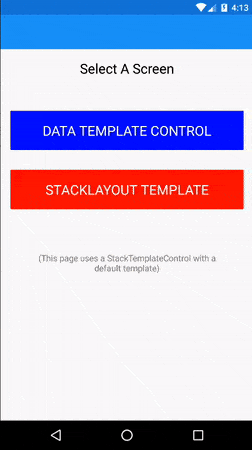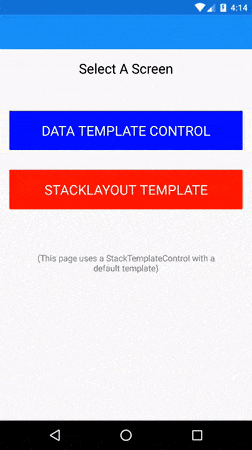SaltyDogControls is a library of Xamarin Forms controls that renders xaml/ui at rutime, providing more flexible UIs without having to rely workarounds such as toggling IsVisible on various
groups of controls. Currently SaltyDogControls has two controls: DataTemplateControl which renders a single DataTemplate in a ContentView, and StackTemplateControl which iterates of an ItemsSource and applies templates to each item as children of a StackLayout.
These two controls provide ways of leveraging the flexibility of DataTemplates. Here are some implications of how this can be used:
- Can provide DataTemplates for certain classes in the global ResourceDictionary, and reuse them in various pages.
- Can dynamically render parts of the Xaml depending on the type of data.
- Converters can be used for smarter lookup logic.
edit: Nuget package coming soon.
Dynamically selects and applies a DataTemplate to the BindingContext at runtime. Template selection will automatically change as the Selector property changes. Rendered DataTemplates are bound as well.
Example Xaml:
<ContentPage
xmlns="http://xamarin.com/schemas/2014/forms"
xmlns:x="http://schemas.microsoft.com/winfx/2009/xaml"
xmlns:sd="clr-namespace:SaltyDog;assembly=SaltyDogControls"
Title="{Binding WidgetName}"
x:Class="DataTemplateSample.TemplateControlPage">
<ContentPage.Resources>
<ResourceDictionary x:Name="resDict">
<x:Array x:Key="TemplateList" Type="{x:Type x:String}">
<x:String>Template 1</x:String>
<x:String>Template 2</x:String>
</x:Array>
<DataTemplate x:Key="Template 1">
<ScrollView Orientation="Vertical">
<StackLayout Orientation="Vertical">
<Label Text="Name:" TextColor="Black" />
<Label Text="{Binding WidgetName}" TextColor="Black" FontSize="Medium" Margin="8,0,0,0"/>
<Label Text="Description:" TextColor="Black" />
<Label Text="{Binding WidgetDescription}" TextColor="Black" FontSize="Medium"/>
<Label Text="Price:" TextColor="Black" />
<Label Text="{Binding WidgetPrice}" TextColor="Black" FontSize="Medium"/>
<Image Source="{Binding WidgetImage}" />
</StackLayout>
</ScrollView>
</DataTemplate>
<DataTemplate x:Key="Template 2">
<Grid>
<Grid.RowDefinitions>
<RowDefinition Height="*" />
<RowDefinition Height="*" />
<RowDefinition Height="*" />
</Grid.RowDefinitions>
<Grid.ColumnDefinitions>
<ColumnDefinition Width="*" />
<ColumnDefinition Width="*" />
</Grid.ColumnDefinitions>
<Image
Source="{Binding WidgetImage}"
Grid.ColumnSpan="2"
Grid.Row="0"
Grid.Column="0" />
<Label Text="{Binding WidgetName}" TextColor="Black" FontSize="Small" Grid.Row="1" Grid.Column="0" />
<Label Text="{Binding WidgetDescription}" TextColor="Black" FontSize="Micro" Grid.Row="1" Grid.Column="1" />
<Label Text="{Binding WidgetPrice}" TextColor="Black" FontSize="Large" Grid.Row="2" Grid.ColumnSpan="2"/>
</Grid>
</DataTemplate>
</ResourceDictionary>
</ContentPage.Resources>
<StackLayout Spacing="0" Padding="16">
<Label Text="Widget Viewer" HorizontalOptions="Center" TextColor="Blue" FontSize="Large" Margin="0,0,0,16" />
<Label Text="Choose Widget Template:" TextColor="Black" FontSize="Medium" />
<Picker x:Name="ThePicker" ItemsSource="{StaticResource TemplateList}" SelectedIndex="0" Margin="0,0,0,32" />
<sd:DataTemplateControl Padding="0" VerticalOptions="FillAndExpand" HorizontalOptions="FillAndExpand"
Selector="{Binding Source={x:Reference ThePicker}, Path=SelectedItem}"
TemplateDictionary="{Binding Source={x:Reference resDict}}"
/>
</StackLayout>
</ContentPage>
Selectoris the property used to lookup the template by name. The value is any object, but is converted to a string at runtime. Can be used with a converter.TemplateDictionaryis anIDictionary<string, object>from which the DataTemplate is retrieved. This can be set to aResourceDictionary, or any implementation ofIDictionary<string,object>
Dynamically selects and applies a DataTemplate to each item in the ItemsSource at runtime. Each item must implement the INameTemplate interface to select the template. Alternatively a default template can be applied to each item.
This is not intended to be a replacement for ListView. ListView is optimized for large lists of data. StackTemplateControl does not face some of the focus challenges that ListView does for editing data.
Example Xaml:
<ContentPage xmlns="http://xamarin.com/schemas/2014/forms"
xmlns:x="http://schemas.microsoft.com/winfx/2009/xaml"
xmlns:sd="clr-namespace:SaltyDog;assembly=SaltyDogControls"
x:Class="DataTemplateSample.Pages.QuestionnairePage">
<ContentPage.Resources>
<ResourceDictionary x:Name="resDict">
<DataTemplate x:Key="StringQuestion">
<StackLayout>
<Label Text="{Binding DisplayName}" TextColor="Black" FontSize="Medium"/>
<Label Text="{Binding QuestionType}" />
<Entry Keyboard="Default" Text="{Binding Value}" />
</StackLayout>
</DataTemplate>
<DataTemplate x:Key="IntQuestion">
<StackLayout>
<Label Text="{Binding DisplayName}" TextColor="Black" FontSize="Medium"/>
<Label Text="{Binding QuestionType}" />
<Entry Keyboard="Numeric" Text="{Binding Value}" />
</StackLayout>
</DataTemplate>
<DataTemplate x:Key="BooleanQuestion">
<StackLayout Orientation="Vertical">
<Label Text="{Binding DisplayName}" TextColor="Black" FontSize="Medium"/>
<Label Text="{Binding QuestionType}" />
<Switch IsToggled="{Binding Value}" />
</StackLayout>
</DataTemplate>
</ResourceDictionary>
</ContentPage.Resources>
<StackLayout Spacing="0" Padding="16">
<sd:StackTemplateControl
x:Name="stackTemplate"
Spacing="0"
Padding="16"
ItemsSource="{Binding Questions}"
TemplateDictionary="{Binding Source={x:Reference resDict}}"
>
</sd:StackTemplateControl>
<Button Text="Submit" Command="{Binding CmdSubmit}" />
</StackLayout>
</ContentPage>
With item types defined as follows:
public enum QuestionType
{
StringQuestion, IntQuestion, BooleanQuestion
}
public class Question : ITemplateSelector
{
public string DisplayName { get; set; }
public QuestionType QuestionType { get; set; }
public object Value { get; set; }
public string TemplateName => QuestionType.ToString();
}
ItemsSourceis the property from which item data is taken, DataTemplates looked up, rendered, and bound.TemplateDictionaryis anIDictionary<string, object>from which the DataTemplate is retrieved. This can be set to aResourceDictionary, or any implementation ofIDictionary<string,object>DataTemplateis a template that can be applied to each item. This allows simple lists of items to be rendered in a StackLayout.
If you have any questions, or would like specific customizations post an issue, or contact the author at curtis@saltydogtechnology.com.

